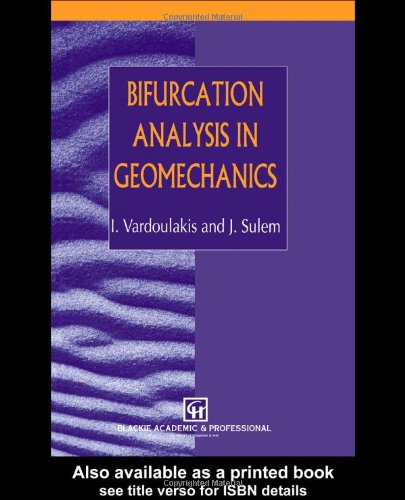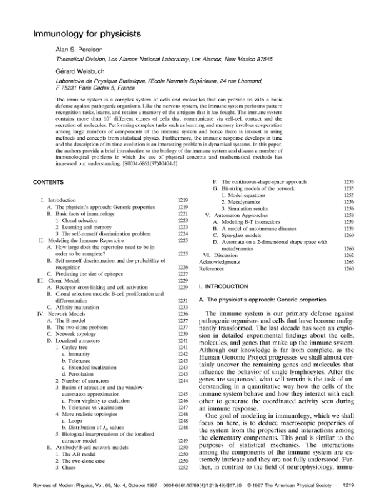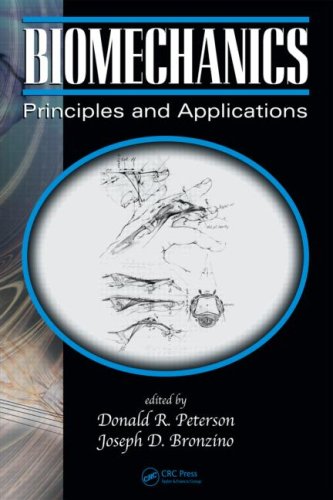J. Sulem, I.G. Vardoulakis0751402141, 9780751402148, 0203697030, 9780203697030, 9780203698068
Table of contents :
Book Cover……Page 1
Half-Title……Page 2
Title……Page 3
Copyright……Page 4
Foreword……Page 5
Preface……Page 7
Contents……Page 9
Acknowledgements……Page 16
Commonly used symbols……Page 17
1.1 A historical note……Page 20
1.2 Observational background……Page 21
1.3 The frame of geomaterials constitutive modeling……Page 24
1.4 Considered topics……Page 29
References……Page 31
2.1.1 Lagrangian description of the deformation……Page 32
2.1.2 Eulerian description of the deformation……Page 35
2.1.3 Deformation of surface and volume elements……Page 37
2.1.4 Static considerations……Page 38
2.2.1 Material time derivative and velocity……Page 40
2.2.2 Relative deformation gradient and its rate……Page 42
2.2.3 Rigid-body or Jaumann derivative……Page 44
2.2.4 Convective time derivative……Page 45
2.2.5 Material derivative of volume integrals……Page 47
2.3.1 Mass balance……Page 48
2.3.2 Balance of linear momentum……Page 50
2.3.3 Balance of angular momentum……Page 51
2.3.4 Energy balance……Page 53
2.3.5 Entropy inequalities and balance……Page 55
2.4.1 Geometric compatibility conditions……Page 57
2.4.2 Kinematic compatibility conditions……Page 59
2.4.3 Dynamic compatibility conditions……Page 61
2.4.4 Weak discontinuities……Page 63
Textbooks and monographs……Page 64
Further reading……Page 65
3.1.1 Kinematical considerations……Page 66
3.1.2 Plane-strain deformations……Page 67
3.1.3 Deformation of line, surface and volume elements……Page 71
3.1.4 Stresses and stress increments……Page 73
3.2.1 Plane rectilinear deformations……Page 79
3.2.2 Superposition of rectilinear deformations……Page 80
3.2.3 Superposition of pure shear……Page 81
3.2.4 Hypoelastic constitutive equations……Page 84
3.3.1 The principle of virtual work……Page 90
3.3.2 The zero moment condition……Page 94
3.3.3 Configuration-dependent loading……Page 97
3.3.4 The linear bifurcation problem……Page 99
3.3.5 Uniqueness theorems under dead loading……Page 101
3.4 Acceleration waves and stationary discontinuities……Page 104
Textbooks and monographs……Page 106
References……Page 107
4.1 Folding of elastic and viscoelastic media as a bifurcation problem……Page 108
4.2.1.1 Formulation of the eigenvalue problem…….Page 109
4.2.1.2 Classification of regimes and functions base…….Page 111
4.2.1.3 Eigendisplacements and tractions at layer boundaries…….Page 114
4.2.2 Buckling of a system of layers—the transfer matrix technique……Page 115
4.2.3 Surface instability of a homogeneous half-space……Page 117
4.2.4 The problem of wavelength selection……Page 120
4.2.4.1 Buckling of a layer on top of a half-space…….Page 121
4.2.4.3 Problem: Buckling of an incompressible Gibson half-space…….Page 122
4.2.5 Interfacial instability……Page 125
4.3 Periodic elastic multilayered media……Page 126
4.3.1 The asymptotic averaging method……Page 128
4.3.2 Example: Surface instabilities in a multilayered periodic half-space……Page 133
4.3.3 Limitations of the asymptotic averaging method……Page 134
4.4.1 Basic concepts……Page 135
4.4.2 The Cosserat model of a multilayered medium……Page 136
4.4.3 Example: Buckling of an homogeneous Cosserat half-space……Page 137
4.5 The effect of surface parallel Griffith cracks……Page 139
4.5.1 Analytical solution for a single crack……Page 140
4.5.2 Buckling of a half-space with a periodic array of coplanar cracks……Page 144
4.5.3 A Cosserat continuum representation……Page 146
4.5.4 Influence of the initial stress field on crack propagation……Page 149
4.6 Concluding remarks and discussion……Page 153
References……Page 154
5.1 Definitions……Page 157
5.2 Mass balance equations……Page 160
5.3 Static considerations: partial and ‘effective’ stresses……Page 162
5.4 The influence of grain and fluid compressibility……Page 164
5.5 Balance of linear momentum……Page 168
5.6.1 Darcy’s law……Page 171
5.6.2 Biot’s modification of viscous and inertial drag……Page 174
5.6.3 Forchheimer’s extension of Darcy’s law……Page 177
5.6.4 Brinkman’s and Aifantis modification of Darcy’s law……Page 179
5.7.1 Governing equations……Page 183
5.7.2 The incremental problem……Page 185
5.7.3 Linear stability analysis……Page 186
5.8.1 Grain crushing……Page 190
5.8.2 Stability of non-uniform compaction……Page 191
Textbooks and monographs……Page 195
References……Page 196
Appendix Characteristic soil properties……Page 197
6.1.1 Kinematics……Page 199
6.1.2 Statics……Page 203
6.2.1 The Mroz-Mandel non-associative elastoplasticity……Page 205
6.2.2 Stress-dependent elasticity……Page 209
6.2.3 Finite strain formulations……Page 213
6.2.4 The equation of thermoelastoplasticity……Page 215
6.2.5 Drucker’s postulate……Page 216
6.2.6 Uniqueness theorems for elastoplastic solids……Page 217
6.3.1 Stress invariants……Page 220
6.3.2 The Drucker-Prager and Mohr-Coulomb models……Page 226
6.3.3 Data reduction and model calibration……Page 230
6.3.4 Lade’s yield surface model……Page 238
6.4.1 Non-potential flow rules……Page 239
6.4.2 Yield surface modifications……Page 244
6.4.3 Modeling of strain softening……Page 245
6.5.1 Model justification……Page 250
6.5.2 Formulation……Page 252
6.5.3 Example of model calibration……Page 258
References……Page 261
7.1 Observational background……Page 265
7.2.1 Problem statement……Page 269
7.2.2 A deformation theory of plasticity……Page 271
7.2.3 Governing equations……Page 273
7.2.4 Bifurcation condition……Page 275
7.3 Bifurcation analysis of the biaxial test……Page 276
7.3.1 Formulation of the diffuse bifurcation problem……Page 278
7.3.2 Classification of regimes and bifurcation condition……Page 280
References……Page 284
8.1.1 The Thomas-Hill-Mandel shear-band model……Page 287
8.1.2 Mandel’s dynamic stability analysis……Page 293
8.2.1 Shear-band analysis in plane strain rectilinear deformations……Page 294
8.2.2 Analysis of a biaxial compression test on sand……Page 299
8.2.3 Imperfection sensitivity of the biaxial test……Page 302
8.2.4 Spontaneous versus progressive localization……Page 303
8.3.1 Influence of porosity……Page 304
8.3.2 Influence of confining pressure……Page 306
8.3.3 Influence of anisotropy……Page 312
8.3.4 Influence of grain size and shape……Page 315
8.4 Non-coaxial plasticity model……Page 316
8.5.1 The cavity inflation test……Page 323
8.5.2 Global bifurcation analysis of the cavity inflation test……Page 327
8.5.3 Progressive failure……Page 333
References……Page 339
9.1.1 Motivation……Page 343
9.1.2 Kinematical considerations……Page 346
9.1.3 Static considerations……Page 350
9.2.1 Kinematics of 2D Cosserat continuum……Page 353
9.2.2 Dynamics and statics……Page 355
9.2.3 Principles of virtual work……Page 358
9.2.4 The boundary-layer effect……Page 361
9.3 The Muhlhaus Vardoulakis Cosserat plasticity model……Page 365
9.3.1 Definitions……Page 366
9.3.2 Elastic strains……Page 367
9.3.3 Plastic strains……Page 368
9.3.4 Constitutive equations……Page 369
9.4 Prediction of the shear-band thickness……Page 371
9.4.1 Governing equations……Page 372
9.4.2 Shear-band solution……Page 374
9.4.3 Analytical and experimental results……Page 377
9.5 Discussion and numerical implications……Page 380
Textbooks and monographs……Page 385
References……Page 386
10.1.1 Kinematics……Page 390
10.1.2 The principle of virtual work……Page 392
10.1.3 Example: Gradient elasticity theory with surface energy……Page 394
10.2.1 Observational background……Page 398
10.2.2 Constitutive modeling……Page 402
10.2.3 Constitutive equations……Page 407
10.2.4 Formulation of the rate-boundary value problem……Page 410
10.2.5 Well-posedeness of the rate-boundary value problem……Page 413
10.3.1 Problem statement……Page 416
10.3.2 Bifurcation analysis……Page 418
10.3.3 The scale effect……Page 420
10.4.1 Constitutive equations……Page 422
10.4.2 Shear-band analysis……Page 426
References……Page 430
11.1 Monotonic biaxial tests on water-saturated sand……Page 432
11.1.1 Experimental basis……Page 433
11.1.2 Simulation and discussion……Page 437
11.2 Theoretical implications……Page 444
11.3.1 Undrained shear banding……Page 446
11.3.2 Linear stability analysis……Page 450
11.3.3 Regularization……Page 453
11.3.4 Globally undrained shear banding……Page 456
11.4 Grain size and shape effect……Page 459
Textbooks and monographs……Page 461
References……Page 462
Index……Page 465







Reviews
There are no reviews yet.